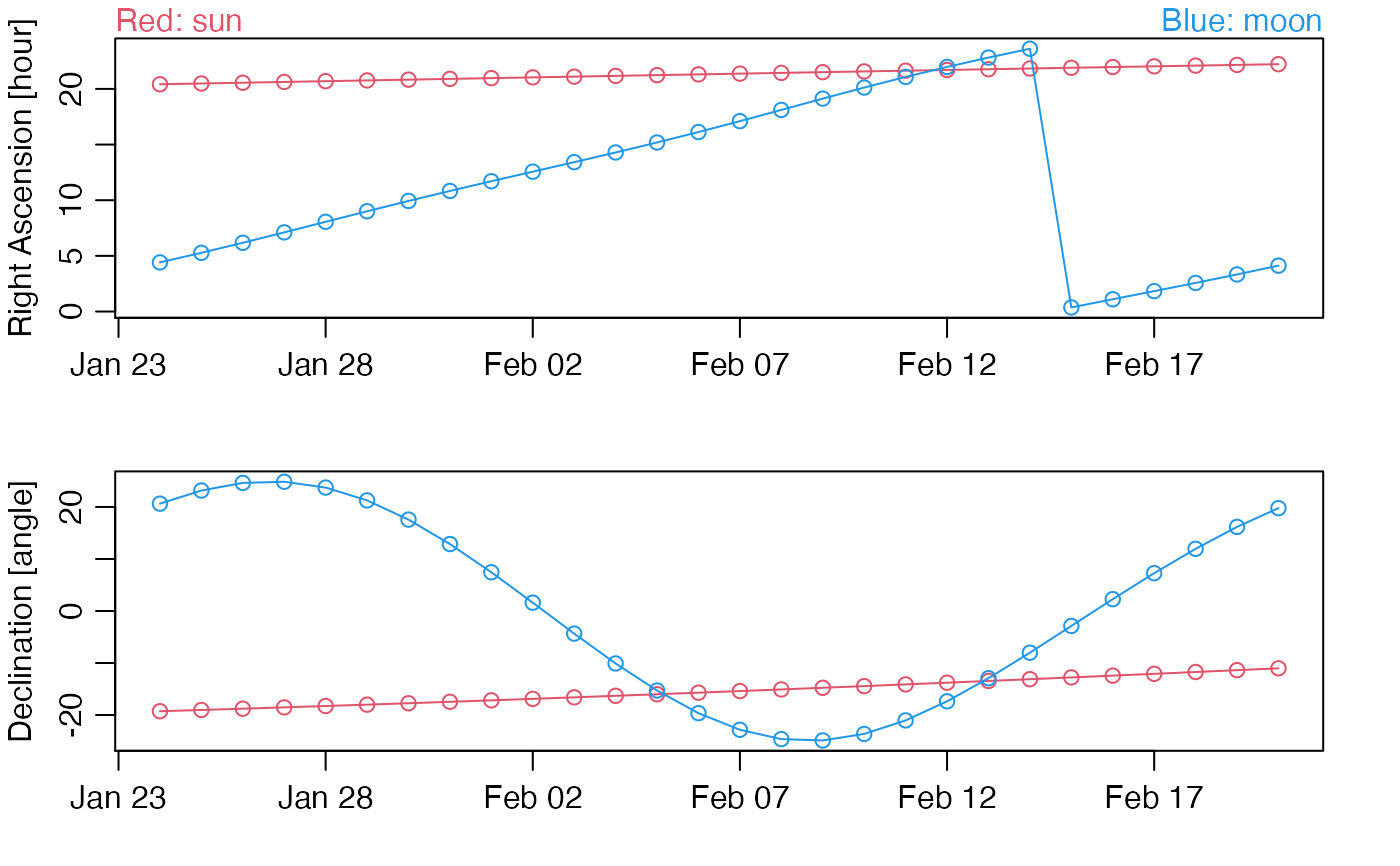Get ephemeris data
ephemeris.RdThis function infers ephemeris data by querying a website (reference 1), and so it requires a web connection to work. It is aimed at people who already know the ideas and terminology of ephemeris computations.
ephemeris( name = "p:Sun", longitude = 0, latitude = 0, t0 = Sys.Date(), nbd = 5, step = 1, observer = "@500", theory = "INPOP", teph = 1, tcoor = 1, rplane = 1, debug = FALSE )
Arguments
| name | character value of the object of interest.
For an explanation of the possible choices, see
https://ssp.imcce.fr/webservices/miriade/howto/ephemcc/#howto-sso.
The sun is indicated with |
|---|---|
| longitude | decimal value of the longitude. Default: 0. |
| latitude | decimal value of the latitude. Default: 0. |
| t0 | POSIXct time (UTC) for the first retrieval, or a string from which
|
| nbd | integer value of the number of times to be retrieved. Default: 5. |
| step | numeric value for the time increment, in days. Default: 1. |
| observer | character value indicating the location of the observer. See
https://ssp.imcce.fr/webservices/miriade/howto/ephemcc/#howto-observer
for an explanation of this quantity.
The default value, |
| theory | character value indicating the planetary theory, with choices
|
| teph | integer value for the type of ephemeris, with 1 for astrometric J2000, 2 for apparent of the date, 3 for mean of the date, or 4 for mean J2000. Default: 1. |
| tcoor | integer value for the type of coordinate, with 1 for spherical, 2 for rectangular, 3 for local, 4 for hour angle, and 5 dedicated to observation. Default: 1. |
| rplane | integer value for the reference plane, with 1 for equator and 2 for ecliptic. Default: 1. |
| debug | logical value indicating whether to perform some
extra checks, and report on progress. Default: |
Value
ephemeris returns a data frame with columns that depend
on the particular call. The default call has columns named
Date, RA, DEC, Dobs, VMag, dRAcosDEC,
dDEC and RV, which are shortened
versions of the names returned by the query, along with
three constructed columns, named time
(a POSIXt object based on Date),
RAdec (a decimal version of RA) and DECdec (a decimal version of
DEC). Other calls have different results.
Details
The names of parameters, and their explanations, are patterned
on Reference 1. It is not easy to guess these things. For example,
the moon is "s:Moon" (where the s indicates a satellite)
and the sun is "p:Sun" (where the p indicates, confusingly,
a planet).
Apart from the listed parameters of this function, the other specifications for the query are set up in the same way as is used in the query-generation examples provided in Reference 1.
Users who are curious about the query should specify debug=TRUE when calling
this function, and they are encouraged to contact the package author, if
they would like any of these hard-wired defaults to be transformed
into a user-adjustable value, via the creation of new parameters
to this function.
The names of parameters, and their explanations, are patterned
on Reference 1. It is not easy to guess these things. For example,
the moon is "s:Moon" (where the s indicates a satellite)
and the sun is "p:Sun" (where the p indicates, confusingly,
a planet).
Apart from the listed parameters of this function, the other specifications for the query are set up in the same way as is used in the query-generation examples provided in Reference 1.
References
The Institut de mécanique céleste et de calcul des éphémérides website https://ssp.imcce.fr/webservices/miriade/api/ephemcc/ is the source of data returned by
ephemeris.
Author
Dan Kelley
Examples
# Month-long time-series plot of Right Ascension and Declination library(ephemeris) s <- ephemeris("p:Sun", nbd=28) m <- ephemeris("s:Moon", nbd=28) par(mfrow=c(2, 1), mar=c(3,3,1,2), mgp=c(2,0.7,0)) RAlim <- range(c(s$RAdec, m$RAdec)) plot(s$time, s$RAdec, type="o", xlab="", ylab="Right Ascension [hour]", col=2, ylim=RAlim) lines(m$time, m$RAdec, col=4, type="o") mtext("Red: sun", col=2, adj=0) mtext("Blue: moon", col=4, adj=1) DEClim <- range(c(s$DECdec, m$DECdec)) plot(s$time, s$DECdec, type="o", xlab="", ylab="Declination [angle]", col=2, ylim=DEClim)
